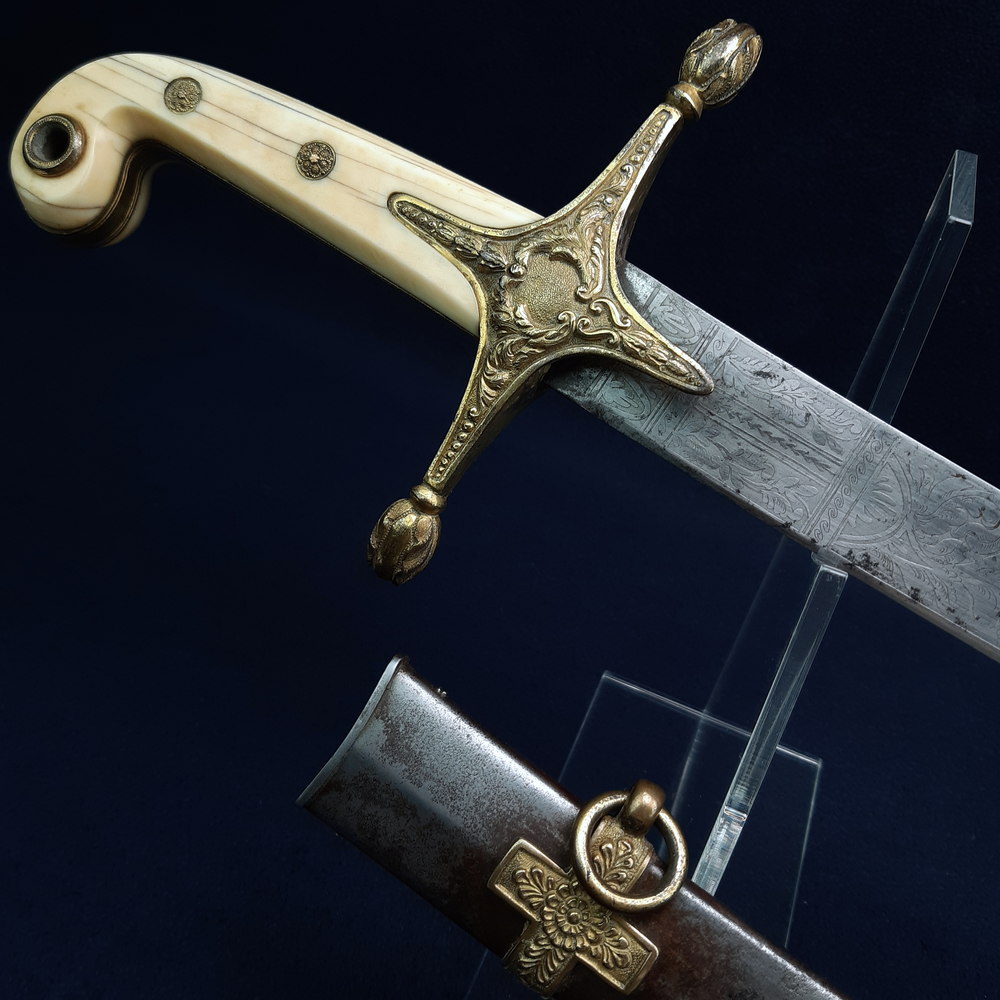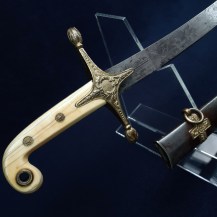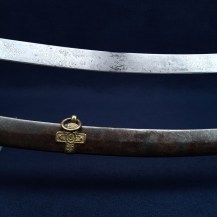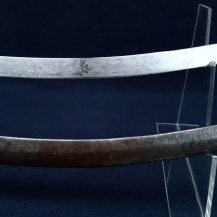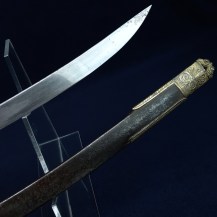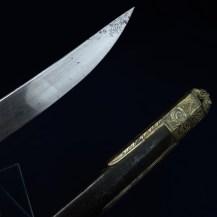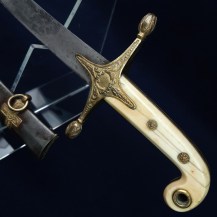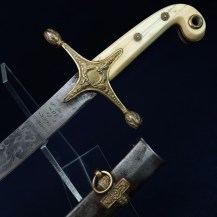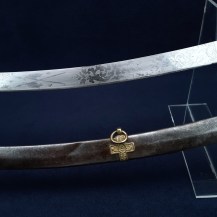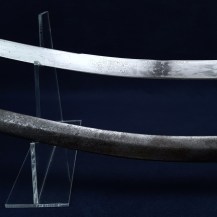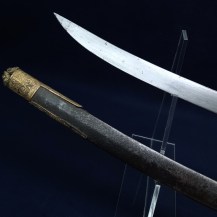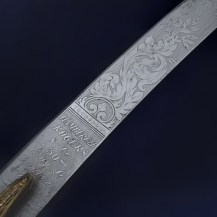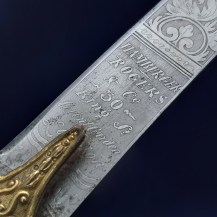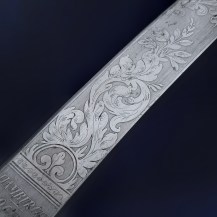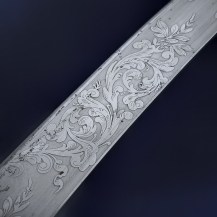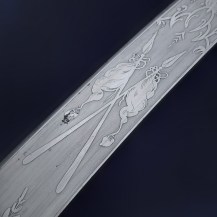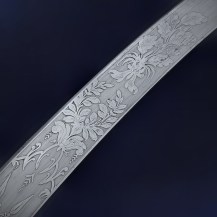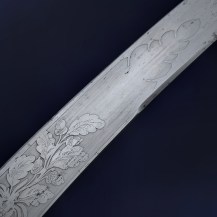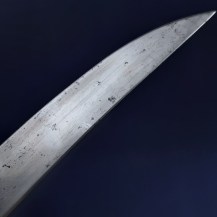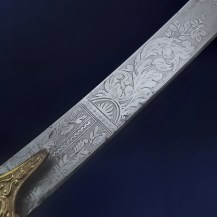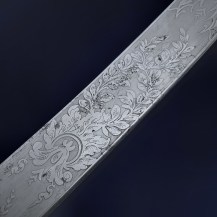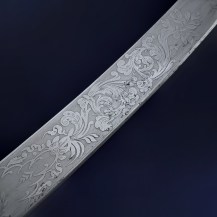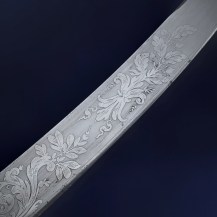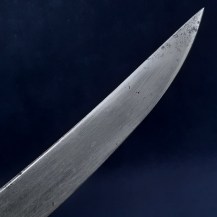British Warwickshire Yeomanry Cavalry Officer’s Full Dress Mameluke Sword by Hamburger Rogers & Co.
Curved, unfullered, hatchet-pointed blade with false edge. Mameluke hilt cast with foliate motifs, with langets and leaf rosette finials. Ivory scale grips secured with decorative rivets, sword knot hole with brass rim. No washer. Scabbard with steel body, steel throat piece, ornate cross-shaped brass band fittings for the hanging rings and ornate brass fitting at the chape. Blade 27 7/8 inches in length, the sword 33¼ inches overall.
The blade is etched on one side with the retailer ‘HAMBURGER ROGERS & Co 30 King St Covent Garden London’, as well as crossed lances with banners and foliate motifs including oak leaves with acorns. It is etched on the other side with further foliage and acorns.
Hamburger & Co. was a firm of gold & silver lacemen established in 1812. As lacemen they produced uniforms for court and cavalry officers, and like many military outfitters also retailed swords. The brothers William and John Rogers joined the partnership in 1840 and it became Hamburger, Rogers & Co. until 1918, so this sword must postdate 1840. Their swords were made by others – the firms Mole, Wilkinson and Reeves all supplied them at various times – but Hamburger was nonetheless notable for supplying unusual regimental swords, having extensive trade with the regiments of the Household Cavalry (which used their own patterns of sword and procured them outside the usual channels) and later procuring custom trooper’s swords for the Westminster Dragoons.
The ‘mameluke’ sword was initially introduced to Europeans during Napoleon’s Egyptian campaigns of 1798-1801, where he fought against and was impressed by the local Mamluk cavalry. The Duke of Wellington owned and carried a mameluke sword from his service in India, and it became an outright craze among British officers to have one as a dress sword. This unofficial trend became officially acknowledged in the 1822 cavalry dress regulations as well as in the 1831 Pattern staff officer’s mameluke sword, which is still carried by General Officers to this day.
Among the light cavalry the mameluke sword was of iconic status: even after Dress Regulations were brought in every Lancer and Hussar regiment retained its own unique variation on the type: always richly decorated and often incorporating regimental motifs in their design. See Chapter 12 of the British Cavalry Sword 1788-1912 by Richard Dellar for extensive discussion of these variations.
Plate 12.16 of the same volume (page 115) depicts an identical mameluke to this one, marked to the Warwickshire Yeomanry and dated c1860-70, which enables identification of this unmarked version. Not every mameluke of a given unit bears regimental etching to prove it: being officer’s swords they would have been privately purchased and such etching would have been an optional extra – this example is well etched but with a more generic pattern.
Four independent troops of yeomanry were raised in the county of Warwickshire in 1794, in Packington, Birmingham, Rugby and Kineton, each of 54 men. These were combined in 1796 to form the Warwickshire Regiment of Yeomanry Cavalry, headquartered at Warwick, which grew to eight troops by 1854.
County yeomanry regiments were composed of (or sponsored by) wealthy gentlemen and their fine uniforms and horses made them great local spectacles and sources of pride for their communities. They also had a law enforcement role: the regiment was first called out in 1795 to aid the civil power in suppressing a riot in Birmingham. This was repeated for the waves of Chartist riots in Birmingham in 1839, 1842 and 1848.
The regiment saw no action overseas until the Boer War, in which it contributed volunteers to the Imperial Yeomanry – in 1900, 5 officers and 116 men formed the 5th (Warwickshire) Company of the 2nd Battalion, then a second contingent of 146 men followed in 1901 which became the 103rd Company. The 5th Company saw combat as mounted infantry, most notably in May 1900, when they were ordered to hold a drift (ford) on the Orange River known as Kheis Drift. The drift led to a wooded river island held by a sizeable party of Boers, which fired on them when they approached. British artillery bombarded the island, then the Warwickshire Company were ordered to cross the river and attack.
The artillery had not deterred the Boers, who laid in wait then opened fire as the British crossed on horseback. Corporal Baxter, one of the lead men, was left wounded in the water, his horse killed under him. Rather than retreating his comrades rushed to his aid despite heavy enemy fire: Trooper Lane and the company commander Major Orr-Ewing were killed recovering Baxter and six others wounded before the withdrawal was complete. Baxter died of his wounds the following night, the incident marking the first casualties in the regiment’s 106 years of history.
In the First World War volunteers from the regiment served with the 2nd Mounted Division, fighting as infantry at Gallipoli in 1915. It was transferred to the Australian Mounted Division in 1917, fighting as cavalry in numerous battles in Palestine including the charge at Huj in 1917, one of the last great charges of the British cavalry. It was then amalgamated into the 100th (Warwickshire and South Nottinghamshire Yeomanry) Battalion, Machine Gun Corps, serving on the Western Front in 1918.
After WW1 the Warwickshire Yeomanry was one of the few regiments which remained as true cavalry – it entered WW2 as part of the 1st Cavalry Division, Britain’s last horseback division, garrisoning Palestine in 1940 and fighting in Iraq and Syria in early 1941. In August 1941 its division was finally mechanized as the 10th Armoured Division, which fought in North Africa and Italy.
It was amalgamated with the Worcestershire Yeomanry in 1957 to form the Queen's Own Warwickshire and Worcestershire Yeomanry. There are two present-day descendant units: B (Warwickshire and Worcestershire Yeomanry) Squadron of The Royal Yeomanry and 54 (Queen's Own Warwickshire and Worcestershire Yeomanry) Support Squadron of the Royal Corps of Signals.
Some small spots of patination and cleaned pitting to the blade, some on the etching. The grips are solidly attached with no cracking. The brass components have a moderate patina. The scabbard has a dent on one side, some dark patination and some pitting to the steel, both heavier towards the chape end. One of the hilt finials is very slightly bent forwards.
Due to the ivory used in the grip, this sword cannot be exported from the UK. It has been declared and registered as antique ivory under the provisions of the UK Ivory Act and therefore can be sold within the UK. Please note that this is a one-time registration: if you purchase this sword and wish to resell it you must register it again.

